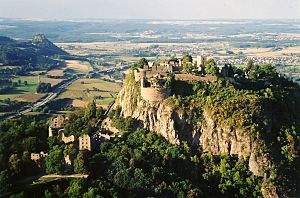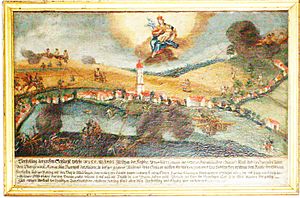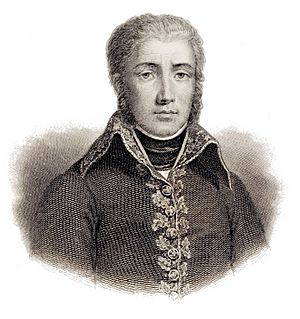Campaigns of 1800 in the French Revolutionary Wars facts for kids
The French Revolutionary Wars were still going strong in 1799. France was fighting against a group of countries called the Second Coalition. Napoleon Bonaparte had just returned from Egypt and taken charge of the French government. He quickly planned new military campaigns. He sent General Moreau to the Rhine River border. Napoleon himself went to lead the army in the Alps mountains. French forces had been pushed almost completely out of Italy in 1799, so Napoleon wanted to win it back.
At the start of the year 1800, Austria had strong armies both north and south of the Alps.
- About 120,000 soldiers were in the Black Forest under General Pál Kray. They were protecting the main route from France to Vienna.
- About 100,000 soldiers were in northern Italy under General Michael von Melas. They were defending Austrian lands in northern Italy and the Po Valley. Napoleon had used this area to attack Vienna before.
France also had its own armies ready:
- About 120,000 soldiers under Moreau were facing Kray.
- About 40,000 soldiers under André Masséna were holding the city of Genoa. They were stopping an invasion of Southern France from Italy.
- About 50,000 soldiers under Berthier formed the Army of the Reserve, based in Dijon.
Both Austria and France decided to focus their main efforts on Italy. Napoleon wanted to attack Kray in Germany by going through Switzerland, but he and Moreau did not get along well.
Contents
Battles in Italy: Napoleon's Big Moves
Melas Attacks First
General Melas attacked first in Italy. By the third week of April, his army had reached the Var River. General Massena and half of his French army were trapped in Genoa. The city was under siege by the Austrians on land and blocked by the Royal Navy at sea. In response, Berthier moved his army to Geneva. Massena was told to hold Genoa until June 4.
Napoleon Crosses the Alps

Napoleon joined the Army of the Reserve. In mid-May, they began to cross the Alps mountains to attack the Austrians from behind. Most of the army crossed through the Great St Bernard Pass, which was still covered in snow. Moving the heavy cannons was incredibly difficult. Soldiers had to pull them with great effort and clever ideas. On May 14, 1800, the 40,000-strong French army was stopped by just 400 Austro-Piedmontese soldiers at Fort Bard in the Aosta Valley. These brave defenders held the pass for two weeks. This completely ruined Napoleon's plan for a surprise attack on the Po Valley.
After crossing the Alps, Napoleon did not go straight to help Genoa. Instead, he marched to Milan. He wanted to improve his supply routes through the Simplon and St Gotthard passes. He also wanted to threaten Melas's supply lines to Mantua and Vienna. Napoleon believed this would force Melas to stop the siege of Genoa. Napoleon entered Milan on June 2. By crossing to the south bank of the Po River, he completely cut off Melas's communications. He took a strong defensive spot at Stradella, confidently waiting for the Austrian army to try and fight its way out.
The Battle of Marengo
However, Melas had not stopped the siege of Genoa. On June 4, the French army marched out of Genoa with all their equipment, heading towards France. This was part of a deal they had made to leave the city. Napoleon then faced a new problem. Because the British controlled the Mediterranean Sea, the Austrians might not retreat. Instead, they could use Genoa as a new base and get supplies by sea. Napoleon's defensive plan would not stop this. He had to find and attack the Austrians before they could regroup.
So, he advanced from Stradella towards Alessandria, where Melas seemed to be doing nothing. Napoleon thought Melas was about to retreat. He sent strong groups of soldiers to block Melas's escape routes north to the Po River and south to Genoa. At this moment, Melas attacked! Despite all his brilliant moves before, Napoleon found himself in a very difficult spot in the Battle of Marengo on June 14.
Napoleon's army was almost defeated in a tough battle during the morning and early afternoon. Melas, thinking he had already won, left the final attack to a subordinate. But then, a French force under Desaix quickly returned. A strong French counter-attack followed. Desaix was killed during this attack, but his return turned the battle into a very important French victory.
After the battle, Melas quickly started talks. This led to the Austrians leaving northern Italy west of the Ticino River. They also agreed to stop military operations in Italy for a while. Napoleon returned to Paris after this victory. He left General Brune to secure control in Italy and begin a march towards Austria.
Campaigns in Germany: A Different Front
Before 1800, there had been other wars. The First Coalition forces had won some early battles. But Napoleon Bonaparte's efforts in northern Italy pushed the Austrian forces back. This led to peace talks and treaties. However, these treaties were hard to put into action. By early 1799, the French government was getting impatient with Austria. New uprisings and gains in Switzerland made France decide it was a good time for another campaign in northern Italy and southwestern Germany.
Armies Face Off
At the start of 1800, the armies of France and Austria faced each other across the Rhine River. Austrian General Pál Kray led about 120,000 troops. His army included soldiers from Bavaria, Württemberg, Mainz, and Tyrol. About 25,000 of his men were protecting the Vorarlberg region east of Lake Constance. Kray placed his main army of 95,000 soldiers in an L-shaped area where the Rhine River changes direction. Kray made a mistake by setting up his main supply base at Stockach, near Lake Constance. This was only a day's march from French-held Switzerland.
General of Division Jean Victor Marie Moreau commanded a French army of 137,000 troops. About 108,000 of these were ready for battle, while the rest guarded the Swiss border and Rhine forts. First Consul Napoleon Bonaparte suggested a plan to outflank the Austrians by attacking from Switzerland. But Moreau refused to follow it. Instead, Moreau planned to cross the Rhine near Basel. A French group would distract Kray while Moreau made his real move.
Key German Battles
Moreau used a series of clever moves, flanking Kray's army multiple times. Soon, Moreau's army was on the eastern side of the Black Forest, while parts of Kray's army were still guarding passes on the other side. Battles took place at Engen and Stockach on May 3, 1800. The fighting near Engen was a stalemate with heavy losses for both sides. However, while the main armies fought at Engen, General Claude Lecourbe captured Stockach from the Austrians. Losing this main supply base forced Kray to retreat to Meßkirch, where they had a better defensive position. But it also meant Kray could not retreat into Austria through Switzerland and the Vorarlberg.
On May 4 and 5, the French launched repeated attacks on Meßkirch, but they failed. At nearby Krumbach, where the Austrians also had a strong position, the French 1st Demi-Brigade captured the village and the high ground around it. This gave them a commanding view over Meßkirch. After this, Kray pulled his forces back to Sigmaringen, with the French following closely. Fighting at nearby Biberach an der Ris happened on May 9. This battle mainly involved the 25,000-man French "Center" led by Laurent de Gouvion Saint-Cyr.
General Moreau then outflanked Kray again, approaching Ulm from the east and overwhelming his outposts at Höchstädt (1800). Kray retreated to Munich. Again, on May 10, the Austrians withdrew with heavy losses, this time to Ulm.
Armistice and Final Battle
A ceasefire, called an armistice, followed for several months. During this time, Archduke John replaced Kray as the Austrian commander. The Austrian army moved back behind the Inn River. Austria was slow to agree to peace terms, so the French ended the armistice in mid-November. When the ceasefire ended, John advanced over the Inn River towards Munich. His army was defeated in smaller battles at Ampfing and Neuburg an der Donau. They were decisively defeated in the forests near the city at Hohenlinden on December 3. Moreau then began a march on Vienna. The Austrians soon signed the Armistice of Steyr, which ended the war in Germany.
Egypt: A Distant Struggle
Meanwhile, General Kléber was still stuck in Egypt because of the British fleet. He made a deal called the Convention of El-Arish with Britain and Turkey to let his army leave by sea. But Britain later changed its mind and refused the agreement. Kléber won a battle against the Turks at Heliopolis in March. However, he was sadly killed later in June.




